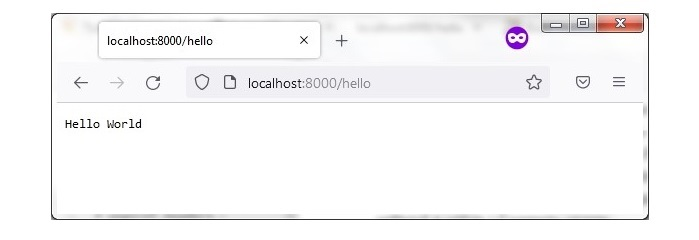
- Python Falcon - Home
- Python Falcon - Introduction
- Python Falcon - Environment Setup
- Python Falcon - WSGI vs ASGI
- Python Falcon - Hello World(WSGI)
- Python Falcon - Waitress
- Python Falcon - ASGI
- Python Falcon - Uvicorn
- Python Falcon - API Testing Tools
- Request & Response
- Python Falcon - Resource Class
- Python Falcon - App Class
- Python Falcon - Routing
- Falcon - Suffixed Responders
- Python Falcon - Inspect Module
- Python Falcon - Jinja2 Template
- Python Falcon - Cookies
- Python Falcon - Status Codes
- Python Falcon - Error Handling
- Python Falcon - Hooks
- Python Falcon - Middleware
- Python Falcon - CORS
- Python Falcon - Websocket
- Python Falcon - Sqlalchemy Models
- Python Falcon - Testing
- Python Falcon - Deployment
- Python Falcon Useful Resources
- Python Falcon - Quick Guide
- Python Falcon - Useful Resources
- Python Falcon - Discussion
Python Falcon - Hello World(WSGI)
To create a simple Hello World Falcon app, start with importing the library and declaring an instance of App object.
import falcon app = falcon.App()
Falcon follows REST architectural style. Declare a resource class that includes one or more methods representing the standard HTTP verbs. The following HelloResource class contains on_get() method that is expected to get called when the server receives GET request. The method returns Hello World response.
class HelloResource:
def on_get(self, req, resp):
"""Handles GET requests"""
resp.status = falcon.HTTP_200
resp.content_type = falcon.MEDIA_TEXT
resp.text = (
'Hello World'
)
To invoke this method, we need to register it to a route or URL. The Falcon application object handles the incoming requests by assigning the handler methods to corresponding URLs by add_rule method.
hello = HelloResource()
app.add_route('/hello', hello)
The Falcon application object is nothing but a WSGI application. We can use the built-in WSGI server in the wsgiref module of Python's standard library.
from wsgiref.simple_server import make_server
if __name__ == '__main__':
with make_server('', 8000, app) as httpd:
print('Serving on port 8000...')
# Serve until process is killed
httpd.serve_forever()
Example
Let us put all these code fragments in hellofalcon.py
from wsgiref.simple_server import make_server
import falcon
app = falcon.App()
class HelloResource:
def on_get(self, req, resp):
"""Handles GET requests"""
resp.status = falcon.HTTP_200
resp.content_type = falcon.MEDIA_TEXT
resp.text = (
'Hello World'
)
hello = HelloResource()
app.add_route('/hello', hello)
if __name__ == '__main__':
with make_server('', 8000, app) as httpd:
print('Serving on port 8000...')
# Serve until process is killed
httpd.serve_forever()
Run this code from the command prompt.
(falconenv) E:\falconenv>python hellofalcon.py Serving on port 8000...
Output
In another terminal, run the Curl command as follows −
C:\Users\user>curl localhost:8000/hello Hello World
You can also open a browser window and enter the above URL to obtain the "Hello World" response.
